Dogs: Books on advanced training
If you want to buy a book, clicking on the book
cover will take you directly to that book on the Amazon.co.uk web site.
See also:
 Dogs:
General Dogs:
General
 Dogs:
Health and Nutrition Dogs:
Health and Nutrition
 Dogs:
Books on single breeds Dogs:
Books on single breeds
 Dogs:
Origins, canine evolution and wolves Dogs:
Origins, canine evolution and wolves
 Dogs: Puppy and manners training Dogs: Puppy and manners training
 Dogs: Behaviour and training philosophies Dogs: Behaviour and training philosophies
 Dogs:
Breeding and kennel management Dogs:
Breeding and kennel management
 Dogs: Fiction
and biography relating to dogs Dogs: Fiction
and biography relating to dogs |
 |
|
|
|
|
|
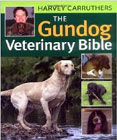
Click on the cover above
to go to this book
at Amazon.co.uk
|

The Gundog Veterinary Bible [Illustrated] (Spiral-bound)
Harvey Carruthers
Quiller Publishing Ltd; Spi edition (29 Jun 2009)
ISBN-10: 1846890500
ISBN-13: 978-1846890505
The Gundog Veterinary Bible a very useful manual for anyone who likes an active life with their dog, not just gundog owners. There is help on what to do in emergencies, such as when a dog has eaten something poisonous, or broken a leg. There is also advice on preventing problems, which is well worth reading, so that you do not have to use the advice for emergencies. The author is the vet columnist of Shooting Times, Harvey Carruthers MRCVS.
The book is very accessible, clearly written, with good illustrations. It is a handy size to take on journeys, and is also spiral bound, so it stays open on a car seat, which means that you can follow instructions and check on the dog at the same time. Very highly recommended.
 Top
of page Top
of page
|

Click on the cover above
to go to this book
at Amazon.co.uk
|

Practical Scent Dog Training
Lue Button
Publisher: Alpine Publications,U.S.; illustrated edition edition (Dec 1990)
ISBN-10: 0931866472
ISBN-13: 978-0931866470
Lue Button has written a very accessible book for anyone interested in scent dog training, whether tracking, trailing or air scenting. This is a practical guide which you can use for working on your own, or with a friend.. It is full of common-sense advice, such as the need to develop your powers of observation and discover how your dog tries to communicate with you. The first six chapters are helpful for all owners, and go a long way towards helping people to develop canine skills, and a better relationship between dog and owner. There are useful preliminary exercises for pups, useful for all pups, not just those destined to become professional scent dogs. The bulk of the book comprises lesson plans for different types of scent work. The lesson plans are clearly set out, with good illustrations in the form of line drawings. There is enough information to help experienced scent dog people who are encountering problems with a particular book. The joy of this book, however, is that is is an eye-opener for any owner who wants to do interesting activities with their dog. Highly recommended, a gem of a book.
 Top
of page Top
of page
|

Click on the cover above
to go to this book
at Amazon.co.uk
|

Clever Dog
Gwen Bailey
Collins (28 May 2009)
ISBN-10: 0007279930
ISBN-13: 978-0007279937
Some people might describe this book as a guide to teaching dogs tricks, but it is far more than this, it can also help you to teach your dog useful jobs, and give him or her some intellectual stimulation. Giving dogs something interesting to do makes them happier, calmer, and helps to improve communication between dogs and owners. They have to pay attention to you in order to get what they want. It's far better to stretch dogs' minds than play mindless ball games in the hope that this will tire them out! My only complaint is that this book is too short, I want more. For serious skills training, working dog books provide more depth, especially those dealing with tracking and retrieving. However, this book is relatively inexpensive, and is highly recommended as a starter book to help owners learn to teach complex skills to their dogs.
 Top
of page Top
of page
|
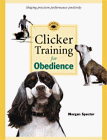
Click on the cover above
to go to this book
at Amazon.co.uk
|

Clicker Training For Obedience
Morgan Spector
Sunshine Books
ISBN 0962401781
This is an excellent introductory guide to clicker training, with very
clear instructions. Clicker training is a reward-based method for training
dogs, which relies on 'clicks' to communicate with the dog. It is a technique
that is based on operant conditioning theories, and it can give rapid
results - either because dogs understand it easily, or because it forces
owners to think about what messages they are sending their dogs! Karen
Pryor is another fan of operant conditioning, and her 'Don't Shoot the
Dog' is perhaps more useful for people with more experience, because she
deals with behavioural issues in greater depth, and helps owners to choose
solutions that best suit them. However, if you want a clear-cut, 'how
to' book, this is the one for you.
 Top
of page Top
of page
|

Click on the cover above
to go to this book
at Amazon.co.uk
|

Agility
Patrick Holden and John Gilbert
Ringpress
ISBN: 1860540449
This is an excellent guide to agility, which is very useful for people
new to this activity, because it is far easier to make sense of commands
taught in agility training if you also have a written and illustrated
overview. It is also a useful resource for experienced owners, because
of the quality of the detailed explanations. The book is certainly a must
have for any agility club, so that it can be lent to members to read at
home.
The focus in the book is on competitive agility, though the authors stress
that it should be fun. Agility is a very good way for owners and dogs
to get to know each other, and for both to have physical and mental exercise
in an enjoyable way. It is such a useful activity that it would be helpful
for non-competing owners to have a little more advice than is given in
this guide. Border collies tend to dominate agility in the UK. Non collie
owners often feel they have little chance of competing with the collies’
intensity, dedication and speed, and may well feel out of place in a club
dominated by collies. Agility, in the sense of obstacle courses that dogs
follow on the direction of their owners, is so useful and enjoyable that
there is a case for expanding the sport, and designing courses for different
breeds. Long-legged dogs, for example, may find the height of the A-ramp
difficult to deal with, so an adjustable version of the A-ramp could be
useful.
This book also focuses on participants in agility, rather than on people
wanting to set agility clubs, or just wanting modified courses in their
back yards. One of the big problems that owners often have is transport
to agility classes. Attending often involves travelling some distance
because agility classes are not as easy to find as obedience classes.
More information for people setting up courses would be helpful.
‘Agility’ is an excellent resource for dog owners, and it is
precisely because this book is so good that it would be a pleasure to
have more from these authors, who perhaps will one day delight us with
a longer version.
 Top
of page Top
of page
|
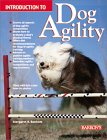
Click on the cover above
to go to this book
at Amazon.co.uk
|

Introduction to Dog Agility
Margaret Bonham
Barron’s
ISBN 0764114395
Dog agility can be very enjoyable for both owners and dogs, and can help
us learn how to communicate with our dogs, as well as helping to channel
the energy of ‘hyper’ dogs into something constructive. So what
if the collies tend to dominate agility classes and competitions, you
can still do agility for fun, and Margaret Bonham shows you how. She covers
all levels of agility activities, from setting up a course in your garden
or a field, to competition events (for you collie owners…). This
book is an excellent introduction for beginners, since it is clearly written,
and is comprehensive enough to be of interest to owners with experience
of agility, and to trainers.
 Top
of page Top
of page
|

Click on the cover above
to go to this book
at Amazon.co.uk
|

Agility Training: The Fun Sport for All Dogs
Jane Simmons-Moake
Howell Bk.Ho.
ISBN: 0876054025
This book is a very useful reference book for people starting an agility
club, or who want to try out agility with friends. There are clear instructions
on how to 'do agility', as well as help with building your own course.
The focus is also on enjoying the sport, rather than taking it in deadly
earnest. Agility is such a useful way of training dogs, and learning to
communicate with them by having fun, that it's refreshing to read a book
that looks at the sport in terms of enjoyment.
 Top
of page Top
of page
|

Click on the cover above
to go to this book
at Amazon.co.uk
|

Tracking Dog: Theory & Methods
Glen R. Johnson
Barkleigh Productions Inc
ISBN: 0914124048
This short book is the 'bible' for trackers from an innovative and highly
experienced handler. Johnson has a wide range of experience from finding
poison leaks, to work with dogs in the armed forces. A 'must-read' for
anyone seriously interested in teaching tracking skills to their dog.
 Top
of page Top
of page
|

Click on the cover above
to go to this book
at Amazon.co.uk
|

Search and Rescue Dogs: Training the K-9 Hero
American Rescue Dog Association
John Wiley & Sons Inc
ISBN: 0764567039
Search and Rescue (SAR) dogs save lives - wandering toddlers, people
trapped in collapsed buildings, or lost in the wilds. This is a gripping
account of their achievements, with advice on how to train them. This
account will give you new respect for the abilities of dogs. Not all dogs
are suited to high-level SAR work, but it is possible to train any dog
to do some of the things that SAR dogs do. Training dogs to find people
on command can bring benefits in terms of improving communication between
you and your dog, and because dogs like to be given jobs to do. You can
also train dogs to find other dogs, which is very useful if you have more
than one dog, and one gets lost. You can even train dogs to find missing
objects, like your car keys!
 Top
of page Top
of page
|
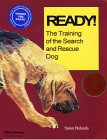
Click on the cover above
to go to this book
at Amazon.co.uk
|

Ready: the Training of the Search and Rescue Dog
Susan Bulanda
Doral Publishing, Inc
ISBN: 0944875416
This is a classic 'how to' book for training Search and Rescue (SAR)
dogs. It's very easy to follow, and gives you a very clear idea of the
training needs of SAR dogs. The rationale behind the training procedures
is explained well, including how handlers should be trained! There is
a troubleshooting guide for helping handlers tackle common problems. The
book is also very well illustrated. This is a very useful resource for
dog clubs, as well as owners interested in SAR work.
 Top
of page Top
of page
|
|

The 10-Minute Retriever
John and Amy Dahl
Willow Creek Press
ISBN: 1572233036
Amy and John Dahl are highly respected trainers in US retrieving circles,
though some of their methods are now seen as old fashioned by many pet
dog trainers. A British pet owner reading their book is making an exploration
into a different dog culture. The dogs trained by the authors, and described
in this book are expected to win competitions. If they don’t do their
jobs well, they are given to other owners as pets. Pet dogs in Britain
tend to be part of the family. They may have useful roles, like keeping
us warm in winter, making sure we get exercise, and keeping burglars at
bay, but they are primarily companions. This difference in roles goes
some way to explaining disagreements on training methods. Amy and John
Dahl want results, above all. People pay them to train their dogs, and
their own dogs have to win competitions to help maintain their reputations.
Retrieving is an optional extra for pet dog owners, something fun to do
if the dog enjoys it, which retrievers usually do. However, most UK pet
dog owners feel there is little point in coercing a companion dog to take
part in a sport, even if coercion may be needed at other times, to keep
dogs out of trouble, so they don’t endanger their own and other lives.
Pet dog training has also developed differently in the UK from in the
US. There is more of a close co-operation between trainers and behaviour
counsellors in the UK than there is between trainers and ´behaviourists´in
the US. Behaviour counsellors in the UK are expected to have training
skills, and to understand dogs from a wide range of perspectives, whereas
´behaviourists´ in the US tend to be more academic, and more
focused on ´´behaviourism´´, as in the view of
learning developed by Skinner and Watson, and popularised by Karen Pryor.
The British APBC, Association of Pet Behaviour Counsellors, long ago moved
away from force in training, and this, in turn, has influenced British
pet dog trainers. The Association of Pet Dog Trainers (APDT), set up by
Fisher, is opposed to the use of coercion in training, so those UK trainers
who have kept their skills up to date have moved away from force. There
are other differences between US and UK pet dog cultures, but a key difference
is that methods based on force are less likely to seen as an option among
pet dog trainers who have kept skills up to date in the UK. This is less
true of British hunting dog culture, where coercive methods are still
common.
What may first strike pet dog trainers, and pet retriever owners about
this book, then, is that some of the methods described, such as jerking
to prevent pulling on the lead, and ear pinching to teach a stage in retrieving,
are now seen as unduly harsh for pet dogs. However, the 10-Minute Retriever
does make very interesting reading, because the authors clearly love training
dogs, and bond with the dogs through training them. It is a very pragmatic
book, based more on decades of refining traditional training methods,
rather than a ‘grand theory’ of training. The authors’
one foray into behaviourism as a way of explaining their methods is a
little confusing, because the terms they use are different, or used in
different ways from terms used by academic behaviourists. Many of the
points the authors stress, which they have learnt from experience, are
the same as those stressed by more ‘softy’ trainers, for example,
that harsh methods tend to be counterproductive, by making dogs less enthusiastic
about working. They also note that jerking on a choke chain can injure
a dog’s neck, that electric collars can make dogs fearful if misused,
and all that collars can do is shock, not teach. They recommend electric
collars for some work, but also suggest using whistles as an alternative
way of communicating to dogs at a distance.
The chapters on puppy training contain little to upset ‘softy’
pet owners and trainers. There is a stress on the need for patience and
encouragement, and not allowing unwanted habits to develop, rather than
chastising pups. These chapters cover good manners, general obedience,
and fostering enthusiasm for retrieving. The authors warn owners to be
restrained over teaching obedience up to the puppy’s limit, because,
though puppies are capable of very high levels of obedience, this can
hinder the development of confidence, desire, and initiative. It is refreshing
to read a book which suggests ways to develop dogs’ cognitive skills
and joie de vivre, as well as obedience.
One particularly interesting section is the discussion of what constitutes
rewards for retrievers, which includes the act of retrieving, praise,
and exercise. Food is not mentioned once. This is a useful reminder that
food is not the only way to motivate dogs, and may not always be the best
way. Food, of course, has many uses in training dogs, but it is possible
to become a ‘food junkie’, so it can broaden our understanding
to hear from trainers who don’t use food at all. Other important
points stressed by this book include the need to keep sessions short (the
ten minutes of the book’s title), to develop skills using a logical
sequence of training ‘building blocks’, and to be consistent.
They remind owners to remember to give a release command to end ‘heel’,
‘stay’ and other commands, something it is easy for owners to
forget. They also stress keeping one’s temper, rather than chastising
dogs for not understanding what one wants, and advise owners never to
train when they feel upset or angry, or to take it personally if dogs
don’t follow what is required.
There are four young Labrador retrievers in the Spanish village where
I live. They are kept in yards with little human contact, and no training.
Here, hunting dogs are just taken out when their owners go shooting, which
may be once a week. These dogs are seen as disposable, usually shot when
they do not do their job properly. Most of these dogs would probably trade
an ear pinch or two for more companionship and more interesting things
to do. Many hunting dogs in the UK are kept outside the home, not (as
is true in much of rural Spain) because they are seen as too big to be
pets, but because owners feel they would be spoiled by too much attention
as pets. Such owners feel that the dogs learn better if the only attention
they receive is while being trained for hunting.
In many hunting dog cultures, in Spain, the UK and US, there are owners
who think they should dominate dogs by means of force, allowing no space
for initiative. This is, of course, a misunderstanding of wolf ethology,
the role of the alpha wolf, and the role of humans as leaders. As Amy
and John Dahl stress, a true leader is sparing with corrections, and has
the confidence to encourage the dog to enjoy retrieving, and to leave
some space for initiative. The result of excessive use of force can be
dogs that gag when a retrieving object is placed in their mouths, and
a lack of trust between owner and dog, so the erosion of a basis for co-operation
between dogs and their owners. Gun dog owners sometimes buy e-collars
over the internet, and treat the dog as though it were a machine with
push button controls, which again can ruin dogs for retrieving. In the
context of some hunting dog cultures, then, this book not only aims to
help owners to get results, but is relatively humane, even though some
of the recommendations may jar with pet dog owners. The authors recommend
that owners live with their dogs in the home, and are sometimes criticised
by hunting dog people in the US for stressing the need for allowing dogs
to have some initiative.
John Dahl describes training retrievers in the early 1950s, and is cheerfully
frank about his early mistakes. He conveys a sense of training as a work
in progress, that new dogs can always teach us something new, which rings
true for people deeply involved in training, rather than just writing
books. Amy Dahl has been experimenting with clicker training. Maybe one
day, when she has built up enough experience, she could be persuaded to
write a book that softy pet owners could happily use, explaining how to
use clickers for retrieving, and whistles for distance work. Only a minority
of retriever owners can, or want to win competitions, while most pet retriever
owners want to have fun with their dogs, and to teach their dogs at least
some of the activities that they were designed to do.
This book is not, then, a complete guide for UK pet retriever owners,
though it could be a useful supplement to more conventional training.
Owners can skip the problematic sections. These problematic sections tend
to deal with skills that can usually be learnt in local obedience classes
in the UK, using methods more suited to companion dogs. It is also easier
to learn how to train a dog in basic obedience and retrieving with the
help of a good trainer than with a book, because a trainer can provide
feedback on the owner’s handling. Labrador and Golden Retrievers
tend to do well in obedience classes, being generally quite robust, large
and easy going. The value of the book as a supplement is because The 10-Minute
Retriever has a lot of useful ‘softy’ advice on specialist retrieving
training, such as fostering enthusiasm in puppies, and teaching retrievers
to like going into water on command, rather than taking a dry land route
(involving entering the water oneself!). As a way of taking retriever
training that bit further, then, this book has something to offer even
to ‘softies’. It is also worth reading simply as an insight
into a different dog culture.
 Top
of page Top
of page
|
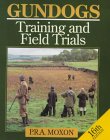
Click on the cover above
to go to this book
at Amazon.co.uk
|

Gundogs: Training & Field Trials
P.R.A. Moxon
Quiller Publishing
ISBN: 1853105856
The late Peter Moxon has been highly influential in the world of gundog
training, and this is an excellent guide for anyone interested in working
gundogs. The illustrations are not as fancy as in some of the more modern
books, but the content more than makes up for this deficiency. There is
a lot of helpful detail, so it's ideal for novices who need clear explanations.
More experienced handlers who have not yet read this work will enjoy it,
and will have a better understanding of the development of gundog training,
since Moxon is such a key figure.
 Top
of page Top
of page
|

Click on the cover above
to go to this book
at Amazon.co.uk
|

Working Gundogs: An Introduction to Training and Handling
Martin Deeley
The Crowood Press
ISBN: 1852237643
Martin Deeley is very well known internationally as a gundog trainer
and author, and 'Working Gundogs' is his introduction for beginners who
are serious about the sport. He looks at both the skills that handlers
need to develop, and at how to select the best pup for the job. He places
a lot of stress on the importance of basic training, and gradually building
up skills. There is also a troubleshooting guide, with examples from his
own experience. The book is clearly written, and the illustrations also
make the explanations easier to understand. The main breeds covered are
the retrieving breeds and spaniels, though owners of other gundog breeds
will find the book useful. This is a very helpful book for people wanting
to start off on the right track.
 Top
of page Top
of page
|
|

Advanced Gundog Training: Practical Fieldwork and Competition
Martin Deeley
The Crowood Press
ISBN: 1861263961
'Advanced Gundog Training' is the next step up from Martin Deeley's
'Working Gundogs'. This book is geared to the more advanced handler, who
wants to participate in UK field trials and formal shoots. Different aspects
of fieldwork covered include rough shooting, wildfowling, pigeon shooting,
and beating. Deeley writes well, and his enthusiasm for the subject comes
through clearly, making this book enjoyable to read, as well as a useful
reference manual.
 Top
of page Top
of page
|

Click on the cover above
to go to this book
at Amazon.co.uk
|

Gundogs: Their Learning Chain
Joe Irving
Quiller Publishing
ISBN: 1840370335
This is a very useful guide to gundog training for novices, which is
worth reading before owners obtain their dogs. Every stage of training
is covered, from selecting the right sort of pup for the handler, to field
work. There are also explanations of the training needs of different breeds
of gundogs, such as the retrieving breeds, spaniels, pointers and setters.
There is a lot of help with building up skills, in the form of lessons
that are clearly explained. Experienced owners will enjoy this book for
its common sense approach and clear explanations, but it's most helpful
for beginners who want to know what gundog training involves.
 Top
of page Top
of page
|
|
|
|